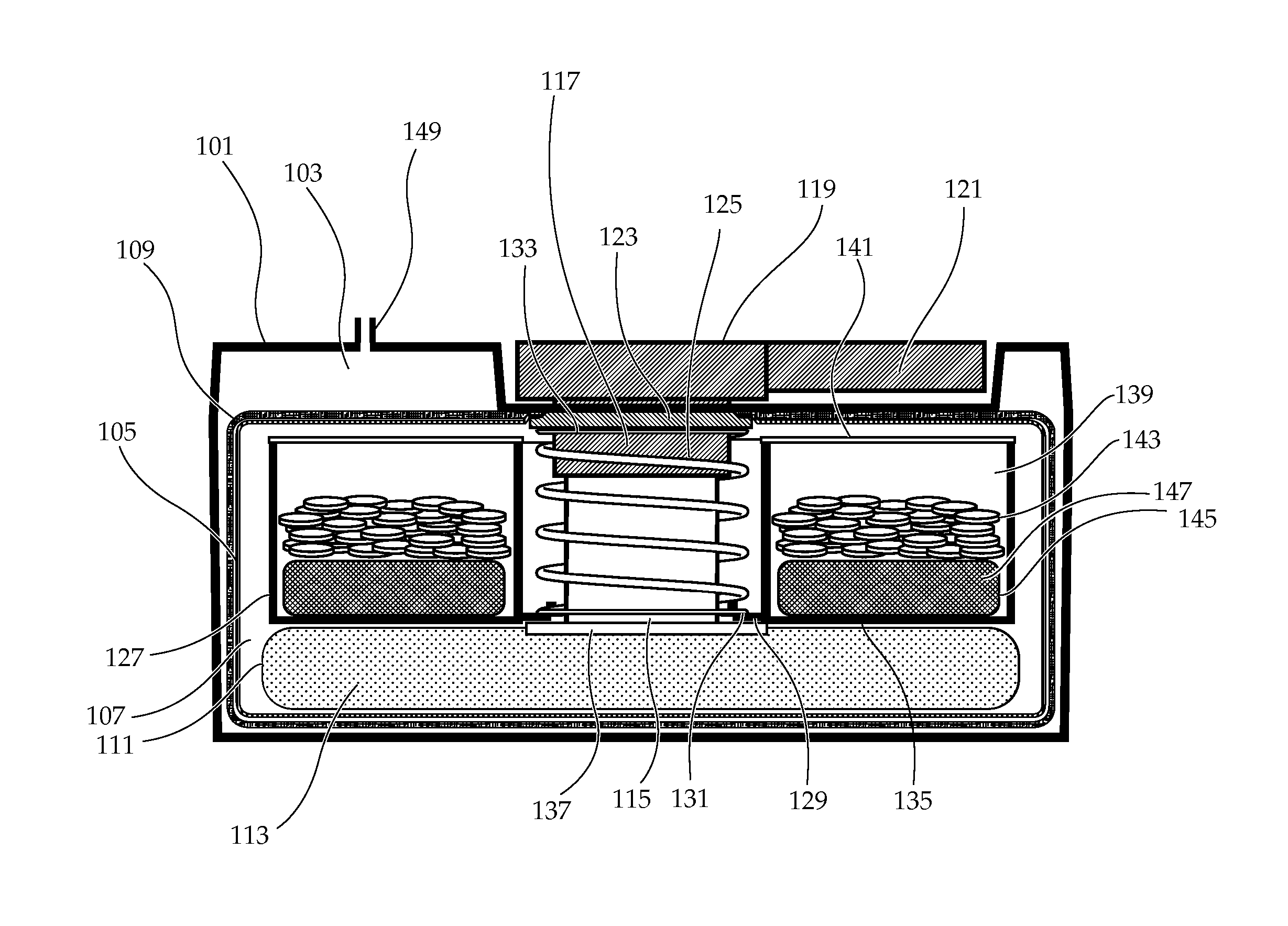Portable chemical oxygen generator
- Summary
- Abstract
- Description
- Claims
- Application Information
AI Technical Summary
Benefits of technology
Problems solved by technology
Method used
Image
Examples
example 1
[0075]Purpose: Determine the purity of oxygen generated by a 3 L / min×30 minute device.
[0076]Procedure: A device was fabricated to deliver 3 L O2 / min for 30 minutes. The oxygen outlet of the device was connected through a one liter low flow reservoir bag via a low flow adaptor air entrainment port to an iVent ventilator (K 052554 7 K 053270, General Electric Company, Schenectady, N.Y.). The iVent ventilator incorporated a Maxtec fuel cell O2 sensor with a digital readout. The outlet loop of the iVent was connected to a one liter “lung” bag and the ventilator was set to deliver a tidal volume of 400 cc at a frequency of 15 with an I:E of 1:2. The iVent received supplemental oxygen from the low flow inlet.
[0077]Results: Approximately 1.5 minutes after the device was activated, the FiO2 reading on the iVent display indicated 100% O2. This reading persisted until the O2 supply from the device was exhausted.
example 2
[0078]Purpose: Determine if any hydrogen peroxide residuals were present in the as-delivered oxygen from a 3 L / min×30 minute device.
[0079]Procedure: A device was fabricated to deliver 3 L O2 / min for 30 minutes. The oxygen produced by the device was bubbled continuously into a beaker containing an acidified 0.02M solution of ferrous ammonium thiocyanate. In the presence of acid, hydrogen peroxide rapidly oxidizes ferrous ion to ferric ion. The ferric ion forms a bright red soluble complex with ammonium thiocyanate. The red complex absorbs strongly in the visible region at 450 nm. Using an absorbance spectrometer to compare the test solution to the as-prepared solution, the presence of hydrogen peroxide can be determined quantitatively to as low as 10 ppm in the oxygen and hydrogen peroxide can be detected at levels of about 1 ppm in the oxygen. A Spec20 digital absorbance spectrometer was used for the measurements.
[0080]Results: Comparison of the test solution to the as-prepared stoc...
example 3
Evaluation of Levels of Volatile Organic Compounds (VOCs) in the Oxygen Produced by a 6 L / min×15 Minute Predicate Device
[0081]Procedure: A device was constructed as above. Activated carbon powder (Fischer Scientific) was added to the super-absorbent fabric barrier by needle punching at a coverage of 15 g / m2. The device utilized Pluronic L-81 (BASF) as an antifoam. L-81 is a PEO-PPO-PEO triblock poloxamer and, like most polymers, is expected to carry some low level of volatile residuals. For example, in headspace GC tests, this poloxamer was found to contain low levels of acetaldehyde. To counter the potential for such residuals to enter the oxygen stream, activated carbon powder was added to the fabric to adsorb any residual VOCs in the oxygen as it passed through the barrier.
[0082]After the device was activated, oxygen was allowed to flow for two minutes after initial inflation of the device. The outlet gas tubing was then connected to a fresh Tedlar gas sampling bag, the valve on ...
PUM
| Property | Measurement | Unit |
|---|---|---|
| Temperature | aaaaa | aaaaa |
| Fraction | aaaaa | aaaaa |
| Fraction | aaaaa | aaaaa |
Abstract
Description
Claims
Application Information
 Login to View More
Login to View More - R&D
- Intellectual Property
- Life Sciences
- Materials
- Tech Scout
- Unparalleled Data Quality
- Higher Quality Content
- 60% Fewer Hallucinations
Browse by: Latest US Patents, China's latest patents, Technical Efficacy Thesaurus, Application Domain, Technology Topic, Popular Technical Reports.
© 2025 PatSnap. All rights reserved.Legal|Privacy policy|Modern Slavery Act Transparency Statement|Sitemap|About US| Contact US: help@patsnap.com



